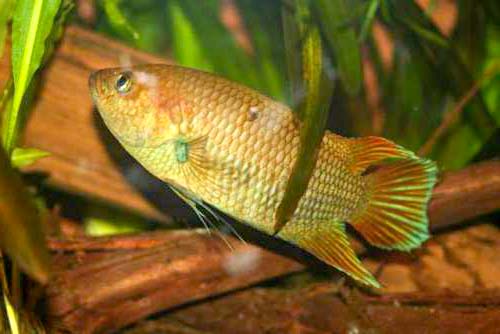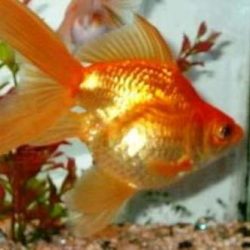Home > Chocolate gourami breeding > Ceylonese combtail – Belontia signata.
The Ceylonese combtail (Belontia signata) is a tropical freshwater fish belongs to the family of gouramis, Osphronemidae, in the order Perciformes (Perch-like) and in the class Actinopterygii (ray-finned fishes).
Ceylonese combtail overview
| Scientific Name: | Belontia signata |
| Species author: | (Günther, 1861) |
| Synonyms: | Polyacanthus signatus Günther, 1861; Macropodus signatus (Günther, 1861) |
| Family: | Osphronemidae › Perciformes › Actinopterygii › Chordata › Animalia |
| Common Name: | Ceylonese combtail; |
| Other languages: | German: Ceylon-Makropode, Ceylon-Stachelflosser; Swedish: Ceylonmakropod; Chinese: 梳尾格斗鱼, 梳尾格鬥魚; Sinhalese: Thalkossa |
| Other names: | combtail, combtail gourami |
| Distribution: | endemic to Sri Lanka |
| Diet and feeding habits: | omnivore, aquatic insects, terrestrial insects, detritus; accepts aquarium feeds |
| IUCN status listing: | Conservation Dependent (LR/cd) |
| CITES listing: | Not Evaluated |
| Human use: | aquarium trade |
Appearance, physical description and identification
The Ceylonese combtail is a freshwater fish growing up a total length (TL) of 18 cm (7.1″). Fish of total length around 10 cm are common. Males are more vibrantly colored with slightly longer fin frills than the females. A healthy Ceylonese combtail will have glossy orange-gold-yellow coloration. The margin of the caudal fin and the base of pectoral fin are pale green. The dorsal and anal fins have orange-red tinge.
Origin, geographical range and distribution
These combtail species are endemic to Sri Lanka. They are common in Mahaweli River basin. The Ceylonese combtail are also found in Kelani and Kalu River basins in Sri Lanka.
Habitat and ecosystem
These combtail species inhabit shallow areas in the slow flowing stream with clear water. The substratum is usually pebbles and sand. The Ceylonese combtail are tropical fish living in shallow water (0 – 1 m) with 24°C – 28°C temperature.
Ceylonese combtail behavior and adaptations
These species are highly aggressive and territorial. They are usually solitary and the juveniles form groups of 3 to 5 individuals. These combtail fish are air-breathing fish. They have a labyrinth organ, which enables them to taking air directly from the surface of the waterbody.
Diet and feeding habits
The diet of the combtail is algal matter, detritus, aquatic insects and terrestrial insects. It is often seen grazing on aquatic plants and algae. In aquarium, they may be fed with live worms, frozen worms, pellets and flake feed.
Reproduction and development in Ceylonese combtail
There is parental care in the Ceylonese combtail fish. The male builds a bubble nest under leaves, aquatic vegetations or submerged overhanging rock. About 500 eggs are spawned and lodged in the bubble nest.
It is a batch spawner, releasing eggs over a period of time. The eggs are demersal, light pink in color and are less than 1 mm in diameter. The male Ceylonese combtail guards the nest and the fry. The female fish tends the nest. The eggs hatch in about 2-3 days.
Conservation status and concerns
The IUCN (International Union for Conservation of Nature) has categorised these combtail species as “Conservation Dependent” (“LR/cd”). Continued species-specific and/or habitat-specific conservation programme is required to prevent Ceylonese combtail from becoming threatened with extinction.
The “Conservation Dependent” category is now re-classed as “Near threatened”, but those species that have not been re-evaluated remain with the “Conservation Dependent” category.
Ceylonese combtail aquarium
Rearing these fish species is of moderate difficulty. They are very sensitive to water quality. A planted aquarium with water circulation and filtration may be prepared and cycled well before introduction of the Ceylonese combtail.

A 100 liter tank is preferred. The pH may be maintained between 7.0 to 7.5. The preferred water temperature is 24°C – 28°C. Soft sandy or pebble substrate is preferred. The aquarium should have hiding places in the form of bog wood and rocks.
| Taxonomy and biological classification of aquarium fish Ceylonese combtail | |
|---|---|
| Kingdom: | Animalia |
| Phylum: | Chordata |
| Class: | Actinopterygii |
| Order: | Perciformes |
| Suborder: | Anabantoidei |
| Family: | Osphronemidae |
| Subfamily: | – |
| Genus: | Belontia |
| Species: | Belontia signata |
| Binomial name: | Belontia signata |
| Popular posts on Ornamental aquarium fish | |
|---|---|
| Chocolate gourami – Sphaerichthys osphromenoides | Chocolate gourami aquarium |
| Saltwater fish aquarium | Freshwater aquariums |
| Tropical fish diseases | Common aquarium fish diseases |
| Fish bowl aquarium | Fish tank aquariums |
| Finding quality breeding platies | Requirements for breeding platies |
| Breeding of platies by beginners | Male platy – female platy |
| Ornamental fish aquarium hobby | Tropical platy fish care |
| Xiphophorus maculatus | Livebearers |
| Mystery snail bowl | African dwarf frog bowl |
| Dwarf gourami fish bowl | Platy fish giving birth |
| Cobitidae | Corydoras |
| Arowana | Cyprinidae |
| Anabantoids | Cichlidae |
| Characidae | White Cloud Mountain minnow |
| Setting up of ornamental fish bowl | The meaning of ornamental fish |
| Selection of an aquarium tank | Aquarium catfish |
| Betta fish bowl | Goldfish bowl |
| Freshwater aquarium fish types | Freshwater aquarium fish species |
| Fish bowl for ghost shrimp | Fish bowl for guppies |
| Cleaning fish bowl | Requirements for fish bowl |
References on Ceylonese combtail:
1.http://www.fishbase.org/summary/6353
Image author: J Bukkems | License: CC BY-NC 3.0
Image source: http://www.fishbase.org/tools/uploadphoto/uploads/1358263899_217.19.29.93.jpg
Current topic in Ornamental aquarium fish: Ceylonese combtail – Belontia signata.

